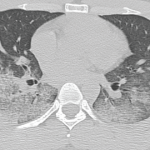However, studies that address the use of alternatives to azathioprine are of interest because not all patients can take that drug, Dr. Seo said. Possible alternatives include methotrexate and mycophenolate mofetil (MMF). A 2008 study from Pagnoux et al that randomized the use of azathioprine or methotrexate for anti–neutrophil cytoplasmic autoantibodies (ANCA)–associated vasculitis found identical relapse rates among patients in both groups.2 The study concludes that methotrexate and azathioprine appear to be similar alternatives for maintenance therapy after initial remission in WG and microscopic polyangiitis patients.
Dr. Seo said other research with mycophenolate mofetil shows different results. The International Mycophenolate Mofetil Protocol to Reduce Outbreaks of Vasculitides (IMPROVE) trial aimed to discover whether MMF is more effective than azathioprine to prevent ANCA-associated vasculitis.3 This open-label, randomized controlled trial took place at 42 centers in Europe over 42 months. Patients received either azathioprine (80 patients) or MMF (76 patients) after remission induction with CYA and prednisolone. Relapses occurred more often in the MMF group; there was an unadjusted hazard ratio of 1.69 for MMF. The study concluded that mycophenolate mofetil was less effective than azathioprine to maintain disease remission, although both treatments had similar adverse event rates.
However, Dr. Seo said, some research has shown the value of MMF for remission induction and maintenance in a group of patients with renal disease.4 A case series of 17 patients with microscopic polyangiitis and mild to moderate renal involvement received corticosteroids for six months and MMF two times a day. Patients continued to receive MMF for 18 months. Remission and stable renal function were the primary outcome measures; 13 of the 17 patients achieved these measures. “Overall, this seems like a very reasonable option,” Dr. Seo said.
Dr. Seo also addressed the question of whether pulse doses of CYC can equally treat patients with ANCA-associated vasculitis. He cited the 2009 Cyclophosphamide Daily Oral Versus Pulsed (CYCLOPS) trial in which 149 newly diagnosed patients who also had renal involvement received pulse CYC, amounting to 15 mg/kg every two to three weeks (76 patients) compared with 73 patients who received daily oral CYC (2 mg/kg/day).4 Both patient groups received prednisolone; once in remission, both patient groups received azathioprine. The two groups did not differ in their time to remission or in the proportion of patients who achieved remission at nine months. The cumulative dose in the daily oral group was larger than patients in the pulse group. “The IV cyclophosamide group was slightly more likely to relapse than the oral group,” Dr. Seo said. “Overall though, the message remains that short courses of cyclophosamide, either oral or IV, for remission induction, followed by longer use of a remission–maintenance agent such as methotrexate or azathioprine is safe and effective for the treatment of Wegener’s granulomatosis and microscopic polyangiitis.”
Biologic Agents for Wegener’s Granulomatosis
A presentation from pulmonologist Ulrich Specks, MD, professor of medicine at Mayo Clinic in Rochester, Minn., focused on data regarding biologic agents in the treatment of WG and microscopic polyangiitis. He zeroed in on the growing role of rituximab for these diseases, citing the results from a trial published in the New England Journal of Medicine regarding rituximab versus CYC for ANCA-associated vasculitis.5 The trial included 197 ANCA-positive patients from nine different centers with one of the two diseases. Patients received rituximab or CYC for remission induction. Glucocorticoids were tapered, and the study endpoint was disease remission with no prednisone use at six months.

